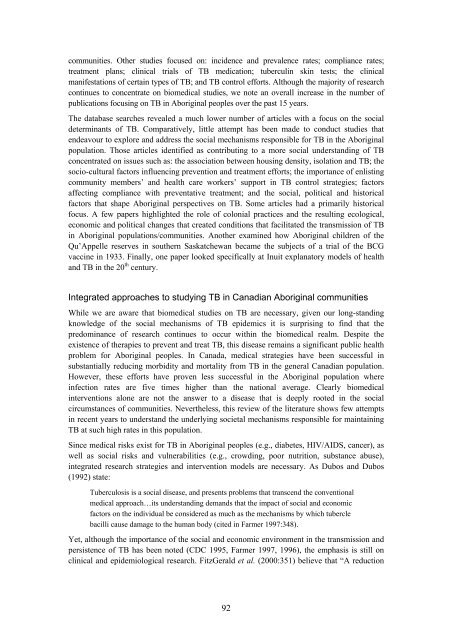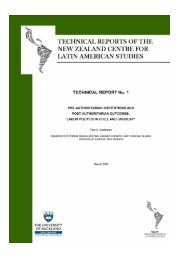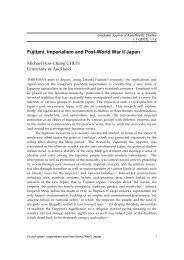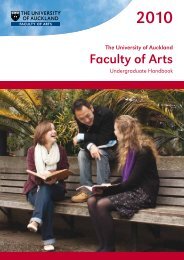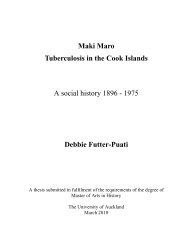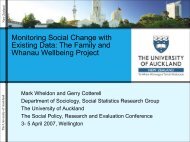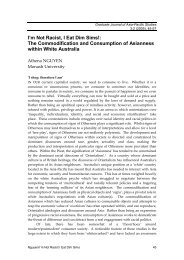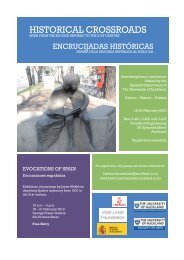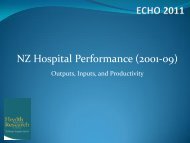Multiplying and Dividing - The University of Auckland
Multiplying and Dividing - The University of Auckland
Multiplying and Dividing - The University of Auckland
You also want an ePaper? Increase the reach of your titles
YUMPU automatically turns print PDFs into web optimized ePapers that Google loves.
communities. Other studies focused on: incidence <strong>and</strong> prevalence rates; compliance rates;treatment plans; clinical trials <strong>of</strong> TB medication; tuberculin skin tests; the clinicalmanifestations <strong>of</strong> certain types <strong>of</strong> TB; <strong>and</strong> TB control efforts. Although the majority <strong>of</strong> researchcontinues to concentrate on biomedical studies, we note an overall increase in the number <strong>of</strong>publications focusing on TB in Aboriginal peoples over the past 15 years.<strong>The</strong> database searches revealed a much lower number <strong>of</strong> articles with a focus on the socialdeterminants <strong>of</strong> TB. Comparatively, little attempt has been made to conduct studies thatendeavour to explore <strong>and</strong> address the social mechanisms responsible for TB in the Aboriginalpopulation. Those articles identified as contributing to a more social underst<strong>and</strong>ing <strong>of</strong> TBconcentrated on issues such as: the association between housing density, isolation <strong>and</strong> TB; thesocio-cultural factors influencing prevention <strong>and</strong> treatment efforts; the importance <strong>of</strong> enlistingcommunity members’ <strong>and</strong> health care workers’ support in TB control strategies; factorsaffecting compliance with preventative treatment; <strong>and</strong> the social, political <strong>and</strong> historicalfactors that shape Aboriginal perspectives on TB. Some articles had a primarily historicalfocus. A few papers highlighted the role <strong>of</strong> colonial practices <strong>and</strong> the resulting ecological,economic <strong>and</strong> political changes that created conditions that facilitated the transmission <strong>of</strong> TBin Aboriginal populations/communities. Another examined how Aboriginal children <strong>of</strong> theQu’Appelle reserves in southern Saskatchewan became the subjects <strong>of</strong> a trial <strong>of</strong> the BCGvaccine in 1933. Finally, one paper looked specifically at Inuit explanatory models <strong>of</strong> health<strong>and</strong> TB in the 20 th century.Integrated approaches to studying TB in Canadian Aboriginal communitiesWhile we are aware that biomedical studies on TB are necessary, given our long-st<strong>and</strong>ingknowledge <strong>of</strong> the social mechanisms <strong>of</strong> TB epidemics it is surprising to find that thepredominance <strong>of</strong> research continues to occur within the biomedical realm. Despite theexistence <strong>of</strong> therapies to prevent <strong>and</strong> treat TB, this disease remains a significant public healthproblem for Aboriginal peoples. In Canada, medical strategies have been successful insubstantially reducing morbidity <strong>and</strong> mortality from TB in the general Canadian population.However, these efforts have proven less successful in the Aboriginal population whereinfection rates are five times higher than the national average. Clearly biomedicalinterventions alone are not the answer to a disease that is deeply rooted in the socialcircumstances <strong>of</strong> communities. Nevertheless, this review <strong>of</strong> the literature shows few attemptsin recent years to underst<strong>and</strong> the underlying societal mechanisms responsible for maintainingTB at such high rates in this population.Since medical risks exist for TB in Aboriginal peoples (e.g., diabetes, HIV/AIDS, cancer), aswell as social risks <strong>and</strong> vulnerabilities (e.g., crowding, poor nutrition, substance abuse),integrated research strategies <strong>and</strong> intervention models are necessary. As Dubos <strong>and</strong> Dubos(1992) state:Tuberculosis is a social disease, <strong>and</strong> presents problems that transcend the conventionalmedical approach…its underst<strong>and</strong>ing dem<strong>and</strong>s that the impact <strong>of</strong> social <strong>and</strong> economicfactors on the individual be considered as much as the mechanisms by which tuberclebacilli cause damage to the human body (cited in Farmer 1997:348).Yet, although the importance <strong>of</strong> the social <strong>and</strong> economic environment in the transmission <strong>and</strong>persistence <strong>of</strong> TB has been noted (CDC 1995, Farmer 1997, 1996), the emphasis is still onclinical <strong>and</strong> epidemiological research. FitzGerald et al. (2000:351) believe that “A reduction92


